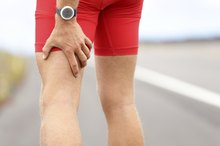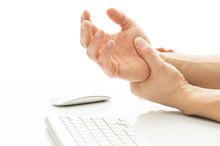Remedy for a Pulled Solar Plexus Muscle
The solar plexus actually refers to a dense cluster of nerve cells and supporting tissue found just below the diaphragm (a broad sheet of muscle underneath the rib cage). A "pulled solar plexus" most likely refers to a either a pulled diaphragm or a pulled abdominal muscle, a low-grade, partial tear to the muscle fibers, usually caused by overstretching. In both cases, following a few easy steps will quickly reduce the swelling, minimize the pain and restore full mobility.
If you are experiencing serious medical symptoms, seek emergency treatment immediately.
Cease Activity
If you pull an abdominal muscle while exercising or playing a sport, immediately cease the activity that caused the injury. If you have suffered a blow to the abdominal region, have a physician examine you to make sure that you have not ruptured the tissue. Then, as soon as possible, begin following the RICE method of treating a pulled muscle.
RICE stands for rest, ice, compression and elevation. Following the steps in that order requires resting the affected muscle and then periodically alternating ice and heat treatments--20 minutes of ice followed by 20 minutes of a heat compress or heating pad. The ice will reduce swelling, while the heat will increase blood flow into the affected area and help to remove toxins.
In place of ice, you can also use a bag of frozen peas, which adds convenience, as it will conform to the affected area, and you can reuse it many times by just putting it back in the freezer to re-chill.
Compression will help minimize the swelling even further, and help speed the healing process.
If you have to move around, compress the injured muscle with an ACE bandage. When resting, keep the injured area elevated so that the swelling drains from the muscle.
Doctors do not recommend applying ice or heat to bare skin but instead using a towel to separate the skin from the ice and heating compress.
- If you pull an abdominal muscle while exercising or playing a sport, immediately cease the activity that caused the injury.
Minimizing the Pain
Exercises for a Brachialis Injury
Learn More
Doctors and physiotherapists recommend a number of anti-inflammatory medications and analgesics to reduce swelling and ease the pain caused by a pulled muscle. Ibuprofen acts as a powerful anti-inflammatory. Aspirin and acetaminophen will help reduce the pain.
Additionally, icing the affected area will both reduce inflammation as well as numb the area, minimizing pain even further.
- Doctors and physiotherapists recommend a number of anti-inflammatory medications and analgesics to reduce swelling and ease the pain caused by a pulled muscle.
- Aspirin and acetaminophen will help reduce the pain.
Getting Back to Full Motion
Low-grade muscle tears (where the muscle has not ruptured, and there is no bruising associated with the injury) can heal quickly 2. The most important part involves ensuring that they heal without causing the build up of scar tissue on the muscle, which can impair future flexibility or mobility. To guard against this side-effect, it's important to begin lightly exercising the pulled muscle within 24 to 48 hours of the injury.
Physiotherapists recommend warming up--by either walking, bicycling, or doing calisthenics that increase blood flow to the affected area--and then gently stretching the muscle. Try to work the entire range of motion of the affected muscle. A self-massage tool (such as "The Stick," widely available online) will also help to make sure that scar tissue does not build-up over the muscle and impair movement in the future.
You can follow this by performing light resistance movements for sets of 10 to 15 repetitions. In the case of a pulled abdominal muscle, do crunches or bicycle motions with no weight. Try to target the affected muscle to make sure that it heals properly along the plane of the muscle.
- Low-grade muscle tears (where the muscle has not ruptured, and there is no bruising associated with the injury) can heal quickly 2.
- A self-massage tool (such as "The Stick," widely available online) will also help to make sure that scar tissue does not build-up over the muscle and impair movement in the future.
Related Articles
References
Writer Bio
Since 2005, James Rutter has worked as a freelance journalist for print and Internet publications, including the “News of Delaware County,” “Main Line Times” and Broad Street Review. As a former chemist, college professor and competitive weightlifter, he writes about science, education and exercise. Rutter earned a B.A. in philosophy and biology from Albright College and studied philosophy and cognitive science at Temple University.








